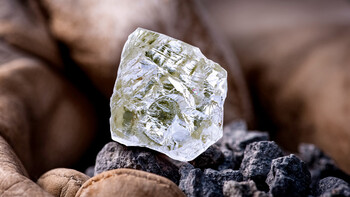Rio Tinto celebrates the extraordinary people, award-winning innovation, and pioneering spirit behind the 20 years of producing brilliant diamonds at the Diavik Mine in Canada’s Northwest Territories.Discovered during the great Canadian diamond rush in the 1990s, Diavik began commercially producing diamonds in 2003. Over the ensuing two decades, Diavik has produced over 140 million carats of rough diamonds through a combination of surface and underground mining. Most of the diamonds recovered at Diavik are white gem quality stones, with a small quantity of yellow diamonds in the mix. The diamonds recovered from this northern mine are prized for their high quality, brilliant internal fire, and Canadian provenance. However, it has been no small task to develop and operate a world-class mine well beyond the end of the road in an area of Canada where winter temperature dip to 40 degrees below zero. The challenges for Diavik are compounded by the fact that the two-billion-year-old diamonds lie below a lake surrounded by permafrost. The safe and efficient development and operation of Diavik has required a combination of fortitude, finesse, and technology.”It is with immense pride that I pay tribute to the extraordinary people who have enabled Diavik to safely produce its beautiful diamonds from one of the world’s most pristine ecosystems,” said Sinead Kaufman, chief executive of minerals at Rio Tinto. “Driven by its pioneering spirit, Diavik is a bold and innovative company with an inspiring story that continues to set new benchmarks for technology, partnerships and sustainability.”Award-winning dike technology was developed to keep the pristine waters of Lac De Gras (Fat Lake) at bay so that the diamonds could be dug up.This northern operation is also famed for its seasonal ice road – a critical artery that traverses frozen lakes and ponds between the mine and the northernmost reaches of Canada’s road system. Open for travel for about two months each winter, the ice road offers an efficient means of delivering thousands of tons of equipment and supplies during the construction of Diavik and continues to be a vital seasonal supply line for the roughly 1,100 people who work at the mine.Among the goods that must be delivered to Diavik is diesel to fuel the equipment and keep the lights on at this remote operation.This is among the reasons Rio Tinto decided to establish an award-winning wind farm at this Far North mining operation.Given Diavik’s remote northern locale and the extremely cold climate that comes with that, the $31 million wind energy project presented a number of transportation, construction, and engineering challenges.And there was no guarantee of success. However, innovative ways were found to prevent the turbines from freezing into inaction during the coldest and darkest days of winter. Today, Diavik is home to the largest wind-diesel hybrid power facility on Earth and is a world leader in delivering cold-climate renewable energy.In addition to the innovations that have led to 20 years of success at Diavik, Rio Tinto is also proud of the strong partnerships that it has built with local communities.These partnerships have led to considerable employment, training, and capacity-building opportunities. Today, Canada’s First People make up a quarter of Diavik’s workforce and roughly 40% hail from Canada’s North.Rio TintoDiavik is a world leader in cold-climate renewable energy.Since 2000, Diavik has spent C$7 billion with Northern businesses, or around 72% of the total business spend over that span. Of this, C$3.6 billion has been spent with Northern Indigenous businesses and their joint ventures.”Being allowed to mine is a privilege and we honor that by working respectfully and through a sense of shared endeavor with our local partners,” said Angela Bigg, president of the Diavik diamond mine. “These are relationships we recognize and value strongly.”Earlier this year, Rio Tinto announced that it is investing US$40 million (C$53.5 million) into an initial phase of underground mining of the A21 open pit at Diavik, which is expected to deliver an additional 1.3 million carats of diamonds by 2026. The company is already looking at a second phase of underground development that will extend this iconic Canadian diamond mine further into its third decade of operations.Author Bio
Shane Lasley, Publisher
Over his more than 15 years of covering mining and mineral exploration, Shane has become renowned for his ability to report on the sector in a way that is technically sound enough to inform industry insiders while being easy to understand by a wider audience.
Email: [email protected] Phone: (907) 726-1095
This article was published by:
Visit the original article here



